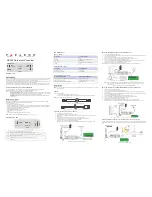
Aktobis AG, Borsigstr. 20, D-63110 Rodgau / Germany
Email: [email protected]
-
Make sure that highly flammable substances (e.g. gases/oils etc.) are never in the vicinity of the unit !
-
Do not use insect, oil or paint spray etc. near the ozone generator. This may cause damage to the unit or even
fire !
-
If you are not going to use the unit for a long time, switch it off and disconnect the mains plug !
-
Do not disconnect the mains plug by pulling on the power cable !
-
Make sure that the unit is earthed at all times !
Please switch off the unit immediately and disconnect it from the mains/power supply if anything seems
to be wrong !!! In this case, please contact a specialist and do not attempt to repair the unit yourself !!!
Operating information:
The ozone generator converts existing oxygen into ozone without the use of chemicals and thus does not pollute
the environment.
Ozone is a special form of oxygen. Normally, two oxygen atoms combine to form an oxygen molecule. The ozone
molecule, on the other hand, consists of a loose compound of three oxygen atoms (O3).
Ozone is one of the purest and most powerful oxidising and germicidal agents. (Ozone is three thousand times
more powerful in killing bacteria than chlorine !)
Oxidation eliminates almost all odours emanating from bad water. This also includes the particularly stubborn
odours such as: Algae, fish, animal, kitchen, waste, urine, chemical and musty odours, as well as all other odours
and smells. Ozone removes odours by breaking down the molecules responsible for the odours, such as hydrogen
sulphide (H2S), ammonia and other organic compounds through chemical reactions.
Almost all germs and bacteria as well as mould are also killed by ozone.
The shelf life of ozone depends, among other things, on the temperature (and humidity). Ozone starts to
decompose again immediately after it is formed, but usually has a half-life of about 20 minutes under normal
conditions. After this time, the ozone decomposes and converts back into oxygen.
The odour that remains is mostly based on a series of harmless compounds caused by the reaction of unsaturated
organic substances with ozone.
Areas of application:
Water treatment
Disinfection/degermination, taste neutralisation, odour neutralisation, oxidation (deferrisation
anddemanganisation as well as destruction of pesticides, cyanides, phenols and algae).
For example:
Drinking water
Pond water
Swimming pool water
Waste water
Fish farming and the commercial and ornamental fish sector
Service water, such as cistern water, well water and other forms of water recycling and water treatment
Other fields of application
Ozone kills the mould immediately and even destroys the mould spores permanently.

























